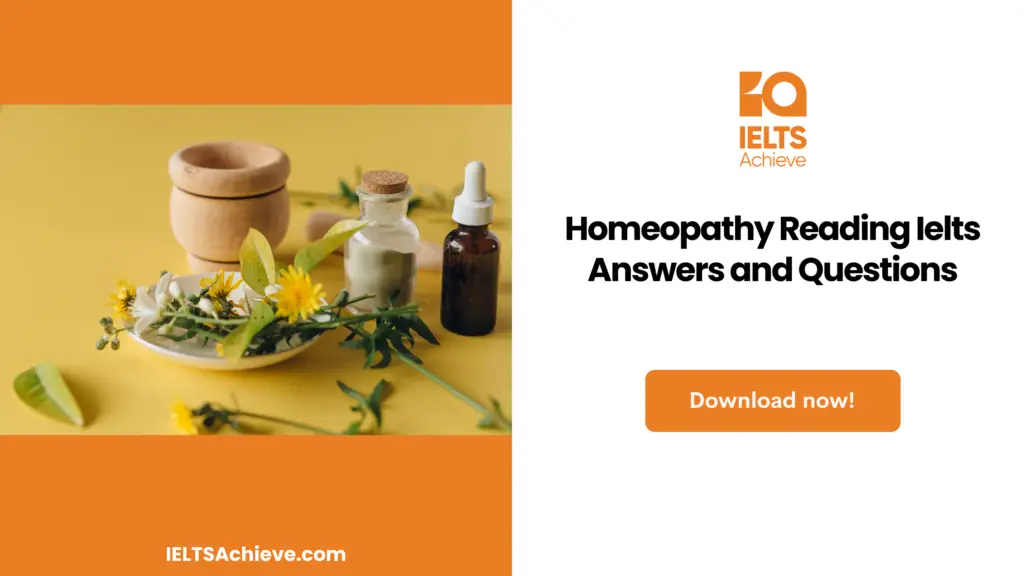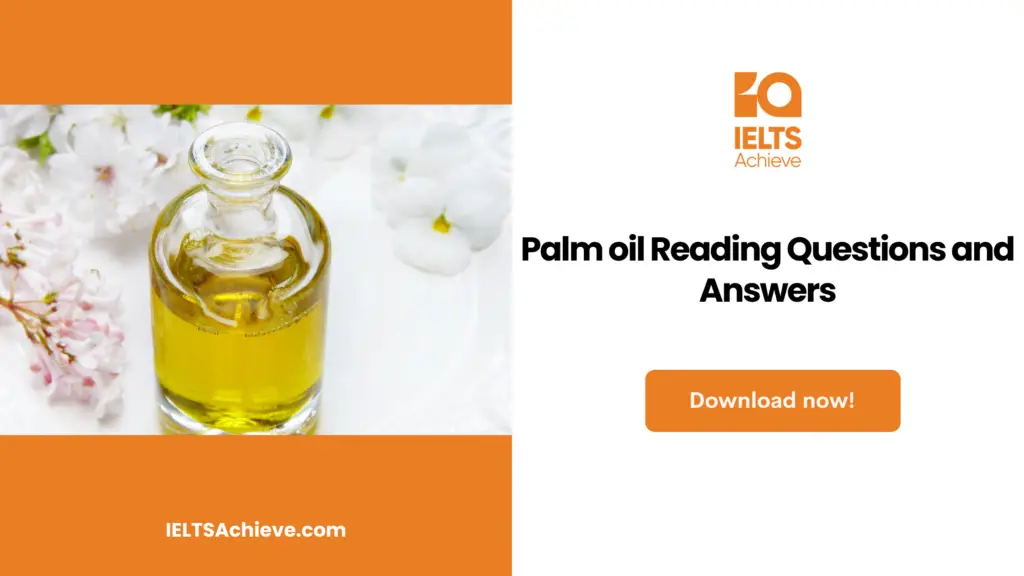The Blog post contains the following IELTS Reading Questions:
- IELTS reading Summary Completion
Stay informed and prepared for success – Explore our comprehensive Reading Test Info page to get valuable insights, exam format details, and expert tips for mastering the IELTS Reading section.
Homeopathy IELTS Reading passage

Homeopathy
Homeopathy is an alternative system of medicine, founded in the early 19th century by a German physician, Dr. Samuel Hahnemann. Since 1980, homeopathy has experienced a strong resurgence of interest in North and South America as well as in Europe. Surveys indicate that more than a third of French physicians have prescribed homeopathic remedies and almost 50 percent of British physicians have referred patients for homeopathic treatment.
Hahnemann’s discovery of the principle of homeopathy was accidental. After taking some quinine, he noticed that he developed malaria-like symptoms. Since malaria patients were treated with quinine, he speculated that possibly malaria is cured by quinine because it causes malaria-like symptoms in healthy people. He decided to explore his theory by testing other substances used as medicine at the time, such as arsenic and belladonna. His tests were conducted by either taking the substances internally himself or by administering them to healthy volunteers and then recording all of the symptoms the volunteers experienced. He continued his experiments on a wide range of natural substances, often toxic. These recorded results created ‘drug pictures’ which formed the basis for the new system of medicine. The next step was to give the tested substances to patients suffering from the same group of symptoms represented by the drug picture recorded. The results were incredible. People were being cured from diseases that had never been cured before. He condensed his theory into a single Latin phrase: similia similibus curentur (let likes be cured by likes). This means that a disease can be cured by a medicine which produces in a healthy person, symptoms similar to those experienced by the patient.
The process of making remedies is very precise. A homeopathic remedy is normally a single substance. The substances may be made from plants, minerals and even animals, for example snake venom and cuttlefish ink. To make remedies, the raw material is dissolved in a mixture that contains approximately 90% alcohol and 10% water. The mixture is left to stand for 2 to 4 weeks, shaken occasionally then strained. The resulting liquid or tincture is then diluted according to very specific measures to a factor of 1:100. For example, to produce a remedy called 1c potency or strength, one drop of the tincture is added to 99 drops of alcohol/water mixture. To produce a 2c potency, one drop of the 1c mixture is added to 99 drops of alcohol/water mixture. Between each mixture the remedy is shaken vigorously. Hahnemann believed that through this process, the energy of the substance was released. Once the remedy has been diluted beyond a 12c potency, it is unlikely that even a molecule of the original substance remains. Yet, ironically, the more dilute the remedy, the stronger it is. This makes no sense in light of present-day science but regardless of what science tells us is impossible, in practice, the higher the dilution the stronger and more lasting the effect.
It is this use of high dilutions that has given rise to controversy. Many conventional doctors claim that homeopathy functions only as a placebo because the dosage is so small. However, the clinical experience of homeopathy shows that this tiny dose can be effective: it works on unconscious people and infants, and it even works on animals. Controlled clinical studies performed by medical researchers are demonstrating that homeopathy can be an effective method of treatment for many diseases.
The most important part of homeopathic treatment lies in the lengthy interview which the homeopath conducts with the patient. The idea behind this one to two hour consultation is to build up a psychological, emotional and physical history of the patient, to discover the underlying patterns of disease. The homeopath then decides which medicine to prescribe based on the closest match between the patient’s symptoms and the known symptoms elicited by the medicine in a healthy body. A single dose is given for the shortest period of time necessary to stimulate the body’s healing power.
How does the concept of homeopathy differ from that of conventional medicine? Very simply, homeopathy attempts to stimulate the body to recover itself. In-stead of looking upon the symptoms as something wrong which must be set right, the homeopath sees them as signs of the way the body is attempting to help itself. Another basic difference between conventional medical therapy and homeopathy is in the role of medication. In much of conventional therapy the illness is controlled through regular use of medical substances. If the medication is withdrawn, the person returns to illness. For example, a person who takes a pill for high blood pressure every day is not undergoing a cure but is only controlling the symptoms. Homeopathy’s aim is the cure: ‘The complete restoration of perfect health,’ as Dr. Hahnemann said.
Homeopathy has made significant progress in treating diseases which orthodox medicine finds difficult. Best at dealing with inflammatory conditions such as arthritis, skin conditions, migraines and respiratory problems linked to allergies, it has also proved highly successful at treating asthma. But homeopathy is not an appropriate treatment for degenerative diseases such as emphysema. It cannot treat diseases which destroy tissue, although it can still be beneficial if used in combination with other treatments. Two of the main advantages of homeotherapy are the low cost of the medications and the rarity of adverse reactions. The medicines are inexpensive, safe, and easy to use, so people can learn to handle many of the common illnesses for which they currently seek medical help. The resulting savings in costs and the increase in personal independence represent a significant contribution to health care.
Unlock your full potential in the IELTS Reading section – Visit our IELTS Reading Practice Question Answer page now!
Recommended Questions:
Renewable Energy IELTS Reading Question with Answer
Questions
Questions 1-6
The reading passage has Sections A-G. Choose the most suitable headings for sections B-G from the list of headings (I-X). Note: There are more headings than sections so you will not use all of them.
| List of Headings The Future of Homeopathy. Concerns about Homeopathy. Comparison with traditional western medicine. Dr. S. HahnemannTheoretical and experimental basis. Revival of Homeopathy. Preparation of medicines. Debate over effectiveness. Advantages and limitations of Homeopathy. Aspects of treatment. |
Example Answer
Section A VI
- Section B.
- Section C.
- Section D.
- Section E.
- Section F.
- Section G.
Questions 7-9
Complete the description below.
Choose NO MORE THAN THREE WORDS from the Reading passage for each answer. And write it in the boxes 7-9.
Making a homeopathic remedy
The remedies come from plant, animal, and mineral sources.
A single product is mixed with 7. __________ and left to stand for 2-4 weeks.
This mixture is strained to produce a tincture that can be diluted.
1 drop of this tincture is added to 99 drops of alcohol/water.
The mixture is then 8. _______________vigorously.
This produces a remedy with a potency of 1c.
As the remedy becomes more diluted, it gets 9. ____________.
Questions 10-13
Complete the summary.
Choose your answers from the table below. And write it in the boxes 10-13.
Homeopathy differs from conventional medicine in a number of ways. Conventional medicine views symptoms as an indication of something wrong in the body whereas homeopathy sees them as signs that the body is attempting to 10. _____________ . The uses of medication differ also. Many types of conventional medication 11. _____________ but if the medicine is taken away, the illness returns. The intention of homeopathy is to bring about a complete cure. Homeopathic remedies are 12. ____________ than conventional medicine and have fewer 13. _____________.
List of Words/ Phrases
| Cheaper | Cure | Heal itself |
| Illness | Treatment | Getting better |
| Control symptoms | More expensive | Side effects |
| Stronger | Healthy | Patients |
Boost your performance in Summary, Notes, Table, and Flowchart Completion tasks. Click here to explore our detailed guide and learn how to effectively complete summaries, notes, tables, and flowcharts in the IELTS Reading section.
Unlock your full potential in the IELTS Reading section – Visit our IELTS Reading Practice Question Answer page now!
Recommended Questions:
Renewable Energy IELTS Reading Question with Answer
Answers for Homeopathy
1. Answer: V
2. Answer: VII
3. Answer: VIII
4. Answer: X
5. Answer: III
6. Answer: IX
7. Answer: Alcohol and Water
8. Answer: Shaken
9. Answer: Stronger
10. Answer: Heal itself
11. Answer: Control symptoms
12. Answer: Cheaper
13. Answer: Side effects

We hope you found this post useful in helping you to study for the IELTS Test. If you have any questions please let us know in the comments below or on the Facebook page.
The best way to keep up to date with posts like this is to like us on Facebook, then follow us on Instagram and Pinterest. If you need help preparing for the IELTS Test, join the IELTS Achieve Academy and see how we can assist you to achieve your desired band score. We offer an essay correction service, mock exams and online courses.

